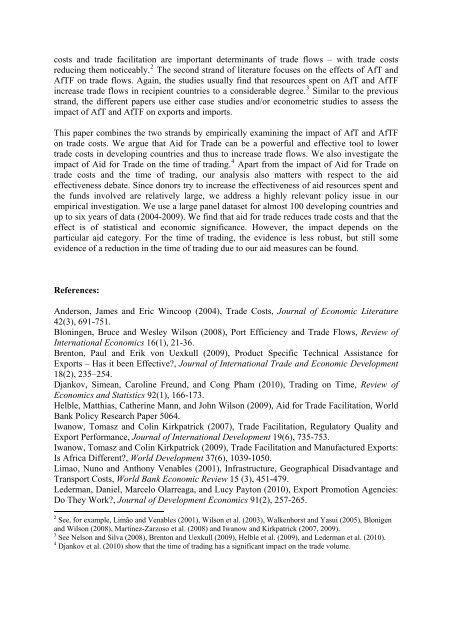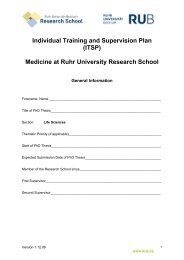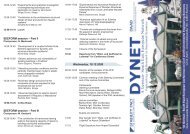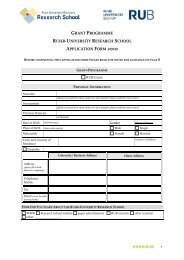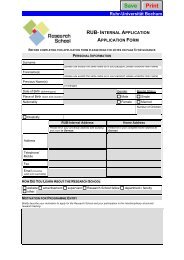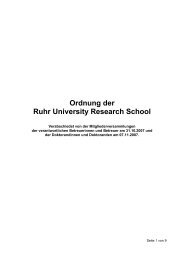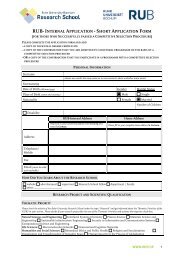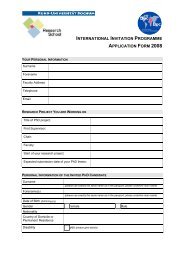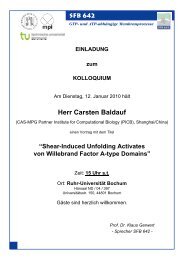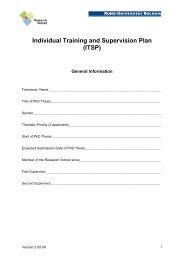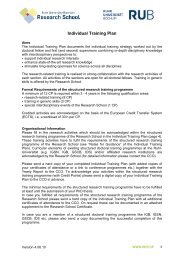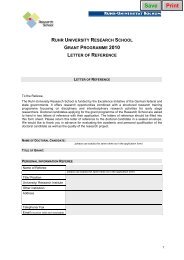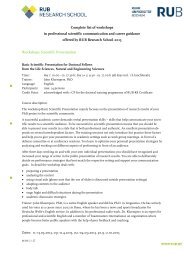Section Days abstract book 2010.indd - RUB Research School ...
Section Days abstract book 2010.indd - RUB Research School ...
Section Days abstract book 2010.indd - RUB Research School ...
Create successful ePaper yourself
Turn your PDF publications into a flip-book with our unique Google optimized e-Paper software.
costs and trade facilitation are important determinants of trade flows – with trade costs<br />
reducing them noticeably. 2 The second strand of literature focuses on the effects of AfT and<br />
AfTF on trade flows. Again, the studies usually find that resources spent on AfT and AfTF<br />
increase trade flows in recipient countries to a considerable degree. 3 Similar to the previous<br />
strand, the different papers use either case studies and/or econometric studies to assess the<br />
impact of AfT and AfTF on exports and imports.<br />
This paper combines the two strands by empirically examining the impact of AfT and AfTF<br />
on trade costs. We argue that Aid for Trade can be a powerful and effective tool to lower<br />
trade costs in developing countries and thus to increase trade flows. We also investigate the<br />
impact of Aid for Trade on the time of trading. 4 Apart from the impact of Aid for Trade on<br />
trade costs and the time of trading, our analysis also matters with respect to the aid<br />
effectiveness debate. Since donors try to increase the effectiveness of aid resources spent and<br />
the funds involved are relatively large, we address a highly relevant policy issue in our<br />
empirical investigation. We use a large panel dataset for almost 100 developing countries and<br />
up to six years of data (2004-2009). We find that aid for trade reduces trade costs and that the<br />
effect is of statistical and economic significance. However, the impact depends on the<br />
particular aid category. For the time of trading, the evidence is less robust, but still some<br />
evidence of a reduction in the time of trading due to our aid measures can be found.<br />
References:<br />
Anderson, James and Eric Wincoop (2004), Trade Costs, Journal of Economic Literature<br />
42(3), 691-751.<br />
Bloningen, Bruce and Wesley Wilson (2008), Port Efficiency and Trade Flows, Review of<br />
International Economics 16(1), 21-36.<br />
Brenton, Paul and Erik von Uexkull (2009), Product Specific Technical Assistance for<br />
Exports – Has it been Effective?, Journal of International Trade and Economic Development<br />
18(2), 235–254.<br />
Djankov, Simean, Caroline Freund, and Cong Pham (2010), Trading on Time, Review of<br />
Economics and Statistics 92(1), 166-173.<br />
Helble, Matthias, Catherine Mann, and John Wilson (2009), Aid for Trade Facilitation, World<br />
Bank Policy <strong>Research</strong> Paper 5064.<br />
Iwanow, Tomasz and Colin Kirkpatrick (2007), Trade Facilitation, Regulatory Quality and<br />
Export Performance, Journal of International Development 19(6), 735-753.<br />
Iwanow, Tomasz and Colin Kirkpatrick (2009), Trade Facilitation and Manufactured Exports:<br />
Is Africa Different?, World Development 37(6), 1039-1050.<br />
Limao, Nuno and Anthony Venables (2001), Infrastructure, Geographical Disadvantage and<br />
Transport Costs, World Bank Economic Review 15 (3), 451-479.<br />
Lederman, Daniel, Marcelo Olarreaga, and Lucy Payton (2010), Export Promotion Agencies:<br />
Do They Work?, Journal of Development Economics 91(2), 257-265.<br />
2 See, for example, Limão and Venables (2001), Wilson et al. (2003), Walkenhorst and Yasui (2005), Blonigen<br />
and Wilson (2008), Martinez-Zarzoso et al. (2008) and Iwanow and Kirkpatrick (2007, 2009).<br />
3 See Nelson and Silva (2008), Brenton and Uexkull (2009), Helble et al. (2009), and Lederman et al. (2010).<br />
4 Djankov et al. (2010) show that the time of trading has a significant impact on the trade volume.


